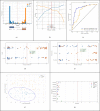The salivary metatranscriptome as an accurate diagnostic indicator of oral cancer
- PMID: 34880265
- PMCID: PMC8654845
- DOI: 10.1038/s41525-021-00257-x
The salivary metatranscriptome as an accurate diagnostic indicator of oral cancer
Abstract
Despite advances in cancer treatment, the 5-year mortality rate for oral cancers (OC) is 40%, mainly due to the lack of early diagnostics. To advance early diagnostics for high-risk and average-risk populations, we developed and evaluated machine-learning (ML) classifiers using metatranscriptomic data from saliva samples (n = 433) collected from oral premalignant disorders (OPMD), OC patients (n = 71) and normal controls (n = 171). Our diagnostic classifiers yielded a receiver operating characteristics (ROC) area under the curve (AUC) up to 0.9, sensitivity up to 83% (92.3% for stage 1 cancer) and specificity up to 97.9%. Our metatranscriptomic signature incorporates both taxonomic and functional microbiome features, and reveals a number of taxa and functional pathways associated with OC. We demonstrate the potential clinical utility of an AI/ML model for diagnosing OC early, opening a new era of non-invasive diagnostics, enabling early intervention and improved patient outcomes.
© 2021. The Author(s).
Conflict of interest statement
The following authors are/were employees of Viome Inc, a commercial for-profit company, at the time of their contributions: G.B., O.O., R.T., S.R., F.C., P.J.T., S.G., M.P., A.P., H.T., and M.V. For the other authors there is no conflict of interest to the best of our knowledge.
Figures



Similar articles
-
Evaluation of CSTB and DMBT1 expression in saliva of gastric cancer patients and controls.BMC Cancer. 2022 Apr 30;22(1):473. doi: 10.1186/s12885-022-09570-9. BMC Cancer. 2022. PMID: 35488257 Free PMC article.
-
Association of salivary cortisol and psychological burden in patients with oral cancer and oral potentially malignant disorders: A prospective study.J Cancer Res Ther. 2023 Apr;19(Supplement):S0. doi: 10.4103/jcrt.jcrt_530_22. J Cancer Res Ther. 2023. PMID: 37147974
-
Isolation and Quantification of MicroRNAs from Human Saliva.Methods Mol Biol. 2019;2054:105-114. doi: 10.1007/978-1-4939-9769-5_6. Methods Mol Biol. 2019. PMID: 31482450
-
The Effectiveness of Artificial Intelligence in Detection of Oral Cancer.Int Dent J. 2022 Aug;72(4):436-447. doi: 10.1016/j.identj.2022.03.001. Epub 2022 May 14. Int Dent J. 2022. PMID: 35581039 Free PMC article. Review.
-
Adjunctive Techniques and Diagnostic Aids in the Early Detection of Oral Premalignant Disorders and Cancer: An Update for the General Dental Practitioners.J Pharm Bioallied Sci. 2022 Jul;14(Suppl 1):S28-S33. doi: 10.4103/jpbs.jpbs_635_21. Epub 2022 Jul 13. J Pharm Bioallied Sci. 2022. PMID: 36110790 Free PMC article. Review.
Cited by
-
Microbiota changes: the unseen players in cervical cancer progression.Front Microbiol. 2024 Feb 8;15:1352778. doi: 10.3389/fmicb.2024.1352778. eCollection 2024. Front Microbiol. 2024. PMID: 38389527 Free PMC article. Review.
-
Noncoding RNAs in oral cancer.Wiley Interdiscip Rev RNA. 2023 May-Jun;14(3):e1754. doi: 10.1002/wrna.1754. Epub 2022 Aug 12. Wiley Interdiscip Rev RNA. 2023. PMID: 35959932 Free PMC article. Review.
-
A review of machine learning methods for cancer characterization from microbiome data.NPJ Precis Oncol. 2024 May 30;8(1):123. doi: 10.1038/s41698-024-00617-7. NPJ Precis Oncol. 2024. PMID: 38816569 Free PMC article. Review.
-
Saliva-based microfluidic point-of-care diagnostic.Theranostics. 2023 Jan 31;13(3):1091-1108. doi: 10.7150/thno.78872. eCollection 2023. Theranostics. 2023. PMID: 36793864 Free PMC article. Review.
-
A salivary biomarker panel to detect liver cirrhosis.iScience. 2023 Jun 5;26(7):107015. doi: 10.1016/j.isci.2023.107015. eCollection 2023 Jul 21. iScience. 2023. PMID: 37360686 Free PMC article.
References
-
- American Society of Clinical Oncology. Head and neck cancer guide. https://www.cancer.net/cancer-types/head-and-neck-cancer/introduction (2019).
-
- World Health Organization. Oral cancer. https://www.who.int/cancer/prevention/diagnosis-screening/oral-cancer/en/ (2020).
Grants and funding
LinkOut - more resources
Full Text Sources

